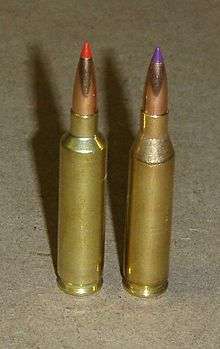.243 Winchester
| .243 Winchester | ||||||||||||||||||||||||
|---|---|---|---|---|---|---|---|---|---|---|---|---|---|---|---|---|---|---|---|---|---|---|---|---|
 .243 Winchester cartridge | ||||||||||||||||||||||||
| Type | Rifle | |||||||||||||||||||||||
| Place of origin | USA | |||||||||||||||||||||||
| Production history | ||||||||||||||||||||||||
| Designer | Winchester | |||||||||||||||||||||||
| Manufacturer | Winchester | |||||||||||||||||||||||
| Produced | 1955 | |||||||||||||||||||||||
| Variants | .243 Winchester Improved (Ackley) | |||||||||||||||||||||||
| Specifications | ||||||||||||||||||||||||
| Parent case | .308 Winchester | |||||||||||||||||||||||
| Bullet diameter | .243 in (6.2 mm) | |||||||||||||||||||||||
| Neck diameter | .276 in (7.0 mm) | |||||||||||||||||||||||
| Shoulder diameter | .454 in (11.5 mm) | |||||||||||||||||||||||
| Base diameter | .471 in (12.0 mm) | |||||||||||||||||||||||
| Rim diameter | .473 in (12.0 mm) | |||||||||||||||||||||||
| Case length | 2.045 in (51.9 mm) | |||||||||||||||||||||||
| Overall length | 2.7098 in (68.83 mm) | |||||||||||||||||||||||
| Case capacity | 52 or 53[1] to 54.8gr H2O[2] | |||||||||||||||||||||||
| Rifling twist | 1-10 to 1-8 | |||||||||||||||||||||||
| Primer type | Large Rifle | |||||||||||||||||||||||
| Maximum pressure (SAAMI) | 60,000 psi (410 MPa) | |||||||||||||||||||||||
| Ballistic performance | ||||||||||||||||||||||||
| ||||||||||||||||||||||||
|
Test barrel length: 24" | ||||||||||||||||||||||||
The .243 Winchester (6×52mm) is a popular sporting rifle cartridge. Initially designed as a target/varmint round, it may be used for animals such as coyotes, blacktail deer, whitetail deer, mule deer, pronghorns, and wild hogs. Rounds of at least 90 grains are better suited for hunting the larger of those while rounds less than 90 grains are more suitable for varmints.[3] The .243 is based on a necked down .308 cartridge case. It is very popular with target shooters, metallic silhouette, and long range shooters, because of its accuracy and low recoil.
History

This cartridge was first introduced in 1955 for the Winchester Model 70 bolt-action and Model 88 lever-action sporting rifles and quickly gained popularity among sportsmen worldwide.[4] Just about every major manufacturer offers rifles chambered in .243.
It was a ground-breaking development, combining a useful combination of lightweight (70 to 85 grain) bullets optimized for long-range performance for varmint hunters (groundhogs, coyotes, prairie dogs) and 90- to 105-grain bullets suitable for game up to the size of deer and pronghorn antelope. Its predecessor in the Winchester lineup, the very similar .257 Roberts, could have easily been selected to accomplish the same tasks, but was not available factory loaded with either lighter, varmint-weight bullets or pointed, long range spitzer (pointed) bullets, so it never achieved the popularity of the newer round.
Remington also saw the 6 mm (.243") family as suitable for this dual-purpose use and introduced their version, the .244 Remington, in the same year (1955) based upon the .257 Roberts necked down to accept .243 bullets up to 90 grains in weight. The Winchester round remains available today whereas the .244 Remington, later renamed the 6mm Remington with the introduction of 100-grain bullets, is far less popular even though it can push all bullet weights slightly faster with maximum loads due to the larger capacity case. The fact that the .243 Win was originally offered in a 1 in 10" rifling twist rate, a rate better able to stabilize heavier, 100- and 105-grain bullets, versus the .244 Remington's 1 in 12" twist (hence the 90-grain factory offering) was also a factor in their popularity.
Since the enactment of the Deer Act 1963 in the United Kingdom, which stipulates a minimum bullet diameter of .240 inches, together with minimum levels of muzzle velocity and bullet energy, the .243 is now perceived as the entry-level caliber for legal deer-stalking. Firearms that would normally be chambered in .308 Winchester/7.62×51mm NATO are sometimes available in .243 in countries–such as Spain–whose regulations restrict or forbid private ownership of so-called military calibers (restricted to bolt action/repeating rifles). No military is known to currently designate this round for service.
In a non-sporting context, bolt-action rifles chambered for the .243 were utilized by the Los Angeles Police Department's special weapons And tactics (SWAT) unit during its early years.[5] A specialist 115 grain projectile can move up to 3,150 fps from a 28-inch barrel, or over 3,000 fps from a 26-inch barrel.[6]
P. O. Ackley created an improved version of this cartridge called the .243 Winchester Improved (Ackley).[7] Like other improved cartridges, this created a steeper shoulder and blew the sides out, giving about 10% more powder capacity, and some small improvement in velocity. Both versions of the .243 cartridge are good for hunting deer.
Performance
The .243 produces a velocity of 2,960 feet (902.21 m) per second with a 100-grain (6.6 gram) projectile from a 24-inch (610 mm) barrel. Commercially loaded .243 ammunition is available with bullet weights ranging from 55 grains (3.6 g) up to 115 grains (6.8 g). Twist rate of the barrel is the major deciding factor in which bullets to use, 1:10 being the most popular as it is sufficient to stabilize up to 100-gr. bullets. However, for very low drag-profile and bullets heavier than 100 grs., a 1:8 or 1:7 (for 115-gr. VLD bullets) is necessary.


See also
References
- ↑
- ↑
- ↑ 243 Win
- ↑ Cartridges of the World 8th Edition, Book by Frank C. Barnes, DBI Books, 1997, ISBN 0-87349-178-5
- ↑ Hunting and Fishing in WV. (27 June 2009). In theintermountain.com. Retrieved 15 September 2010 from http://theintermountain.com/page/content.detail/id/519830.html?nav=22%5Bpermanent+dead+link%5D
- ↑ ,
- ↑ Handbook for Shooters & Reloaders vol I, Book by P.O. Ackley; Plaza Publishing, 1962, ISBN 978-99929-4-881-1 p.305
External links
- .243 Winchester Cartridge Guide by AccurateShooter.com
- Cartridge Dimensions
